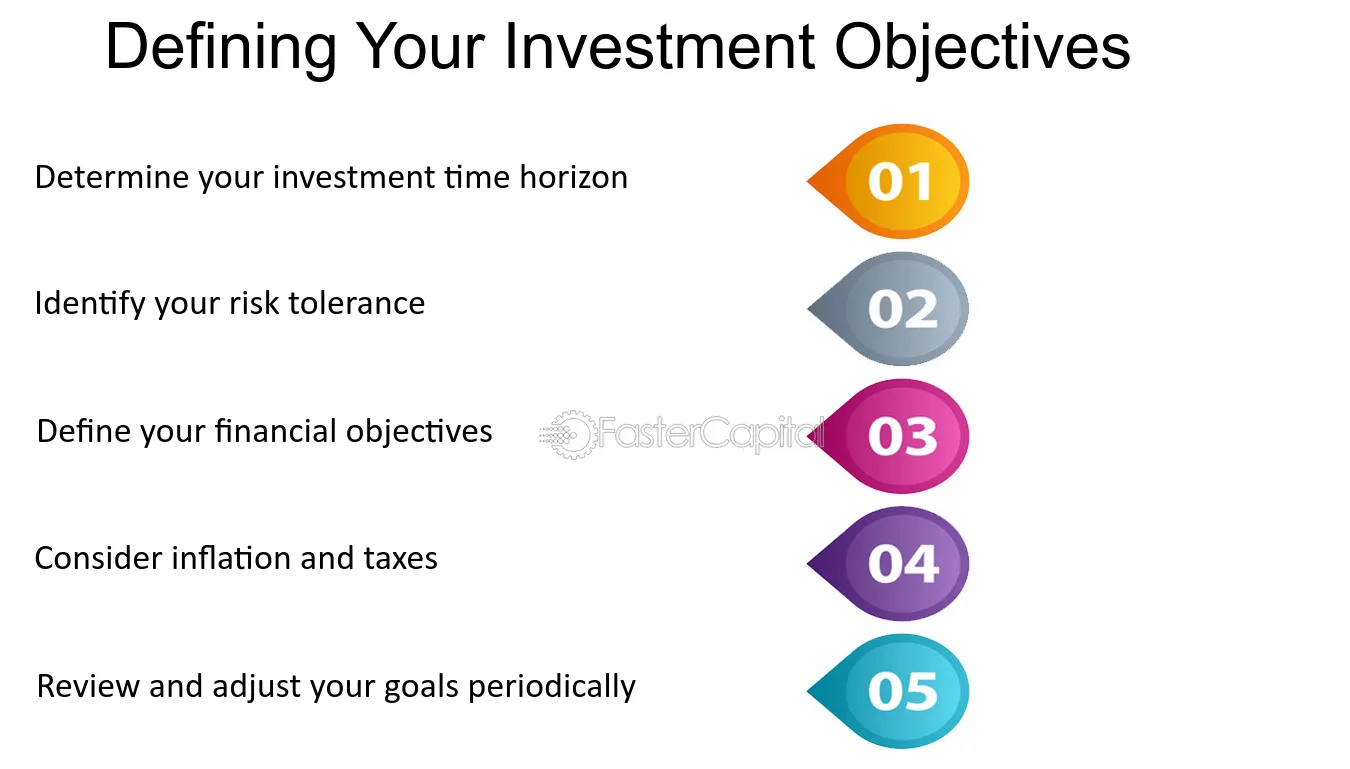What is Investment Objective?
An investment objective is a financial goal that an investor sets for themselves when deciding where to allocate their funds. It serves as a guiding principle for portfolio construction and helps investors determine the appropriate investment strategy to achieve their desired outcomes.
Importance of Investment Objectives
Investment objectives are crucial because they provide clarity and direction to investors. They help investors define their goals, whether it’s capital preservation, income generation, or capital appreciation. By clearly defining their objectives, investors can align their investment decisions with their financial goals.
Types of Investment Objectives
There are several types of investment objectives, including:
- Capital Preservation: The objective is to protect the initial investment and minimize the risk of loss.
- Income Generation: The objective is to generate a regular stream of income through investments, such as dividends, interest, or rental income.
- Capital Appreciation: The objective is to achieve long-term growth in the value of the investment.
- Risk Management: The objective is to manage and mitigate investment risks to protect against potential losses.
- Socially Responsible Investing: The objective is to invest in companies or funds that align with the investor’s ethical or social values.
An investment objective is a clear statement of what an investor aims to achieve with their portfolio. It outlines their financial goals, time horizon, and risk appetite. By defining these objectives, investors can make informed decisions about asset allocation and investment strategies.
The importance of investment objectives lies in their ability to provide a roadmap for portfolio construction. Without clearly defined objectives, investors may find themselves making impulsive investment decisions or allocating their assets in a way that does not align with their long-term goals.
Furthermore, investment objectives help investors stay focused and disciplined. In the face of market volatility and short-term fluctuations, having a clear objective can prevent emotional decision-making and keep investors on track towards their long-term goals.
How to Use Investment Objectives for Portfolio Building
Once the investment objectives have been defined, they play a crucial role in portfolio construction. Here are some key considerations on how to effectively use investment objectives for building a portfolio:
Diversification

One of the primary uses of investment objectives is to guide the diversification of a portfolio. Diversification involves spreading investments across different asset classes, sectors, and geographical regions to reduce risk. The investment objectives help determine the desired level of diversification based on factors such as risk tolerance, investment horizon, and financial goals.
Asset Allocation
Investment objectives also inform the asset allocation strategy for a portfolio. Asset allocation involves deciding how much of the portfolio should be allocated to different asset classes, such as stocks, bonds, and cash. The investment objectives help determine the appropriate allocation based on factors such as desired return, risk tolerance, and investment time horizon.
Investment Selection
Once the asset allocation has been determined, investment objectives guide the selection of specific investments within each asset class. For example, if the objective is to achieve long-term growth, the portfolio manager may select growth-oriented stocks or mutual funds. If the objective is to generate income, fixed-income securities or dividend-paying stocks may be chosen. The investment objectives help align the investment selection with the desired outcome.
Monitoring and Rebalancing
Investment objectives also play a role in monitoring and rebalancing the portfolio. Regular monitoring ensures that the portfolio remains aligned with the investment objectives and helps identify any deviations or changes in market conditions. If the portfolio drifts away from the desired asset allocation or risk profile, rebalancing involves buying or selling investments to bring it back in line with the objectives.
| Benefits of Using Investment Objectives for Portfolio Building |
|---|
| 1. Clarity: Investment objectives provide a clear roadmap for portfolio construction, ensuring that investment decisions are aligned with the desired outcomes. |
| 2. Risk Management: Investment objectives help manage risk by guiding diversification and asset allocation decisions. |
| 3. Goal-oriented Approach: Investment objectives help investors focus on their specific financial goals and tailor the portfolio accordingly. |
| 4. Flexibility: Investment objectives can be adjusted over time to accommodate changing market conditions or personal circumstances. |
Overall, investment objectives serve as a guiding framework for portfolio construction, ensuring that the portfolio is designed to meet the investor’s unique needs and objectives. By using investment objectives effectively, investors can build portfolios that are well-diversified, aligned with their risk tolerance, and capable of achieving their financial goals.
Strategies and Considerations for Effective Portfolio Construction

1. Asset Allocation
One of the most important considerations in portfolio construction is asset allocation. This involves determining the optimal mix of different asset classes, such as stocks, bonds, and cash, based on an investor’s risk tolerance, investment goals, and time horizon. By diversifying across different asset classes, investors can potentially reduce the impact of market volatility on their portfolio.
2. Diversification

Diversification is another crucial strategy for portfolio construction. It involves spreading investments across different securities within each asset class. By diversifying holdings, investors can reduce the risk associated with individual securities or sectors. This can be achieved by investing in a mix of stocks from different industries, bonds with varying maturities, and assets from different geographic regions.
3. Risk Management
4. Regular Monitoring and Rebalancing
Portfolio construction is not a one-time process. It requires regular monitoring and rebalancing to ensure that the portfolio remains aligned with the investor’s objectives. Market conditions and asset performance can cause the portfolio to drift from its original allocation. By periodically reviewing the portfolio and making necessary adjustments, investors can maintain their desired asset allocation and risk profile.
5. Consideration of Costs
Investors should also consider the costs associated with portfolio construction. This includes transaction costs, management fees, and taxes. High costs can erode investment returns over time. Therefore, it is important to select investments and investment vehicles that have reasonable costs and fees. This can be achieved by comparing expense ratios, brokerage fees, and tax implications before making investment decisions.
| Strategies and Considerations | Description |
|---|---|
| Asset Allocation | Determining the optimal mix of different asset classes based on risk tolerance and investment goals. |
| Diversification | Spreading investments across different securities within each asset class to reduce risk. |
| Risk Management | Assessing risk tolerance and using risk management tools to protect the portfolio. |
| Regular Monitoring and Rebalancing | Periodically reviewing and adjusting the portfolio to maintain desired asset allocation. |
| Consideration of Costs | Taking into account transaction costs, management fees, and taxes to optimize returns. |
By incorporating these strategies and considerations into the portfolio construction process, investors can increase the likelihood of achieving their investment objectives and building a successful investment portfolio.

Emily Bibb simplifies finance through bestselling books and articles, bridging complex concepts for everyday understanding. Engaging audiences via social media, she shares insights for financial success. Active in seminars and philanthropy, Bibb aims to create a more financially informed society, driven by her passion for empowering others.
